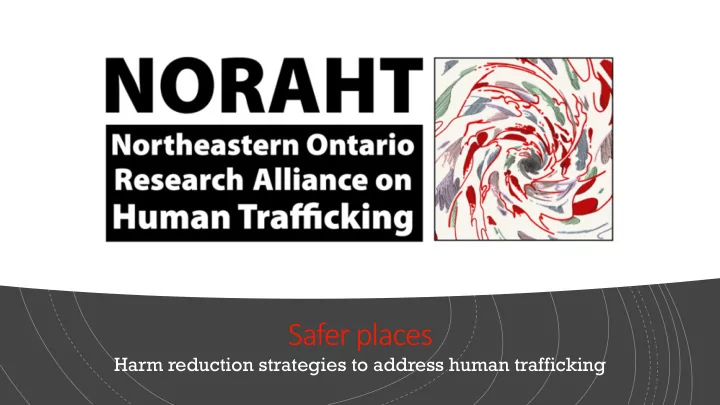

Safer places Harm reduction strategies to address human trafficking
Miigwetch
We are grateful to those who stepped forward to share their journeys § “Owning our story can be hard but not nearly as difficult as spending our lives running from it. Embracing our vulnerabilities is risky but not nearly as dangerous as giving up on love and belonging and joy—the experiences that make us the most vulnerable. Only when we are brave enough to explore the darkness will we discover the infinite power of our light.” ― Brene Brown
Harm Reduction
Objectives To share research findings on human trafficking in Northeastern Ontario To highlight what people of lived experience have asked for in service delivery To share harm reduction strategies for critical anti-human trafficking To identify key principles to safer spaces
Research Partners
Critical anti-human trafficking Guidance from Sex work is not experiential human persons trafficking Empowerment Decolonial and and self- Feminist determination, approaches not rescue
Sex Work does not = Human Trafficking Anti-trafficking efforts are broadly understood to be anti-sex work That eliminates the voices of sex workers and their allies. That contributes to violence experienced by sex workers
Race/ Homelessness/ colonization poverty 2SLGBTQ Addictions Violence Experiences
Policies and programs which attempt primarily to reduce the adverse health, social and economic consequences of mood altering substances to individual drug users, their families and communities, without requiring decrease in drug use. (The International Harm Reduction Association, 2002)
Principles of harm reduction Pragmatism Human Rights Focus on harms Maximize options Priority of Lived experience immediate goals involvement
“Thinking about the time I slipped through the cracks, I wouldn’t listen to teachers, probation officers, the people I would listen to were people on the streets. So I would ideally like to hear from people who are currently or had just left the trade.”
Stigma STIGMA FROM INSTITUTIONALIZED SELF-STIGMA STIGMA BY INDIVIDUALS STIGMA ASSOCIATION
Key elements of stigma § Pathologize § Criminalize § Fear and isolation § Blame and moral judgement § Patronize
Function of stigma Difference Discrimination (keep people (keep people out) down) Danger (keep people away)
Harmful human trafficking responses § End the demand § Public shaming § Priorities of funding/policy § Rescue missions
Ha Harm m Red educt ction Ser Services ces § Peer support § Voluntary § Outreach and education § Low threshold for service access § Opportunity
“I give it a year minimum. If you have a social worker working with that particular girl on the normal things like housing, and ID then you can build relationships and maybe go to college. But I don’t worry about their smarts, they are often huge readers. They don’t fear academics.”
Safer Places
2018 Everyone Counts Nipissing 42% of respondents staying at someone else’s place. 29% staying at emergency shelters 12% did not know where they were spending the night 6% unsheltered location (public place, vehicle, abandoned building) 11% provisionally housed (motel, transitional housing, public institutions).
Demographics 44% IDENTIFIED AS 67% FIRST 27% IDENTIFIED BEING 70% INCOME SOURCE 83% SINGLE ADULTS INDIGENOUS EXPERIENCED IN A FOSTER OR SOCIAL ASSISTANCE HOMELESSNESS PRIOR GROUP HOME TO AGE 25 39% HOMLESSES FOR 31% HOMELESS 3 OR MORE THAN 6 MONTHS MORE TIMES IN THE PAST YEAR
Obstacles to housing RENT PRICES MENTAL HEALTH ADDICTIONS DISCRIMINATION ISSUES
“In the end it comes down to housing. We all know about that, we don’t have that. For everything, even addiction, it comes down to housing. Once they are out of detox, they need housing. If there is no housing you go back to what you know. In all these factors, poverty, drug use, sex trade, all of it – being with a bad man.”
Housing needs § Shelters (24h – longer term) § Transitional housing § Scattered housing § Housed
Organizational Spaces
Trauma informed Safety Choice Collaboration Trustworthiness Empowerment Cultural/gender issues
Trauma informed design § Clear sightlines § Options for seating § Inviting, clutter free § Cultural spaces § Use of calming colours
Harm reduction NON- LOW HOLISTIC ENGAGEMENT TRUST JUDGMENT THRESHOLD
Meets needs Complexity of Individual Rest period Relational Long term experiences
Dignity Showcase client's art Family meal service Accessibility devices Open space to Variety of seating and Label room and (painting, poetry, (handrails, lower interact with staff room choices belongings photography) counters, ramps)
Safety Private bathroom Avoid territorial and shower Open floor plans use of common facilities areas Storage Outdoor viewing Outdoor lighting Pet friendly Locked with staff
Health and Wellbeing Access to cultural Easy access to water, Plant life inside and out Landscape Natural light Financial literacy spaces restrooms, showers, laundry, computers, exercise space
Empowering Strength Choices Dignified Self- Peer led based determination
https://www.homelesshub.ca/sites/default/files/attachments/Everyone%20Count s_NipissingDistrict_FindingsReport_2018.pdf § Everyone Counts Nipissing 2018 http://sexworklawreform.com/wp-content/uploads/2019/02/CASWLR-Human- Trafficking-Response.pdf § Movie Backwards n the Fight Against Human Trafficking in Canada Sources/Resources https://www.tandfonline.com/doi/full/10.1080/10530789.2016.1260879 § Creating safe spaces: designing day shelters for people experiencing homelessness http://www.vawlearningnetwork.ca/webinars/recorded-webinars/2019/webinar- 2019-6.html § Trauma-Informed Responses to Human Trafficking https://noraht.nipissingu.ca/ § NORAHT
Donna Debassige -Elder Rosemary Nagy –Nipissing University Brenda Quenneville –Centered Fire Counselling and Consulting Kathleen Jodouin -Victim Services of Nipissing District Rebecca Timms –Anishinabek Nation Lanyan Chen –Nipissing University Gina Snooks –Research Assistant Sydnee Wiggins –Research Assistant
Recommend
More recommend